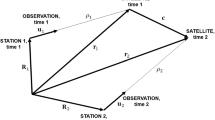Abstract
For satellite conjunction prediction containing many objects, timely processing can be a concern. Various filters are used to identify orbiting pairs that cannot come close enough over a prescribed time period to be considered hazardous. Such pairings can then be eliminated from further computation to quicken the overall processing time. One such filter is the orbit path filter (also known as the geometric pre-filter), designed to eliminate pairs of objects based on characteristics of orbital motion. The goal of this filter is to eliminate pairings where the distance (geometry) between their orbits remains above some user-defined threshold, irrespective of the actual locations of the satellites along their paths. Rather than using a single distance bound, this work presents a toroid approach, providing a measure of versatility by allowing the user to specify different in-plane and out-of-plane bounds for the path filter. The primary orbit is used to define a focus-centered elliptical ring torus with user-defined thresholds. An assessment is then made to determine if the secondary orbit can touch or penetrate this torus. The method detailed here can be used on coplanar, as well as non-coplanar, orbits.
Similar content being viewed by others
References
Baluyev R.V., Kholshevnikov K.V.: Distance between two arbitrary unperturbed orbits. Celest. Mech. Dyn. Astron. 91, 287–300 (2005)
Coppola, V.T., Dupont, S., Ring, K., Stoner, F.: Assessing satellite conjunctions for the entire space catalog using COTS multi-core processor hardware. In: AAS/AIAA Astrodynamics Specialist Conference, Pittsburgh, Paper AAS 09-374 (2009)
Gronchi G.F.: An algebraic method to compute the critical points of the distance function between two Keplerian orbits. Celest. Mech. Dyn. Astron. 93, 295–329 (2005)
Hoots F.R., Crawford L.L., Roehrich R.L.: An analytical method to determine future close approaches between satellites. Celest. Mech. Dyn. Astron. 33, 143–158 (1984)
Kelso, T.S.: NORAD Two-Line Element Set Format http://celestrak.com/NORAD/documentation/tle-fmt.asp. Accessed 24 Jan 2012
Kelso, T.S., Alfano, S.: Satellite Orbital Conjunction Reports Assessing Threatening Encounters in Space (SOCRATES). In: 15th AAS/AIAA Space Flight Mechanics Conference, Copper Mountain, Colorado, Paper AAS 05-124 (2005)
Swets J.A., Dawes R.M., Monahan J.: Better decisions through science. Sci. Am. 283(4), 82–87 (2000)
Woodburn, J., Coppola, V., Stoner, F.: A description of filters for minimizing the time required for orbital conjunction computations. In: AAS/AIAA Astrodynamics Conference, Pittsburgh, Paper AAS 09-372 (2009)
Woodburn, J., Dichmann, D.: Determination of close approaches for constellations of satellites, Paper No. C-5. In: IAF International Workshop on Mission Design and Implementation of Satellite Constellations, Toulouse (1997)
Xue D., Li J.: Collision criterion for two satellites on Keplerian orbits. Celest. Mech. Dyn. Astron. 108, 233–244 (2010)
Author information
Authors and Affiliations
Corresponding author
Rights and permissions
About this article
Cite this article
Alfano, S. Toroidal path filter for orbital conjunction screening. Celest Mech Dyn Astr 113, 321–334 (2012). https://doi.org/10.1007/s10569-012-9421-3
Received:
Revised:
Accepted:
Published:
Issue Date:
DOI: https://doi.org/10.1007/s10569-012-9421-3




